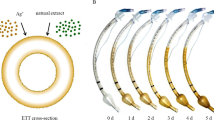Abstract
Ventilator associated pneumonia (VAP) is a serious and costly clinical problem. Specifically, receiving mechanical ventilation for over 24 hours increases the risk of VAP and is associated with high morbidity, mortality and medical costs. Cost effective endotracheal tubes (ETTs) that are resistant to bacterial infection could help prevent this problem. The objective of this study was to determine differences in the growth of Staphylococcus aureus (S. aureus) on nanomodified and unmodified polyvinyl chloride (PVC) ETTs under dynamic airway conditions. PVC ETTs were modified to have nanometer surface features by soaking them in Rhizopus arrhisus, a fungal lipase. Twenty-four hour experiments (supported by computational models) showed that air flow conditions within the ETT influenced both the location and concentration of bacterial growth on the ETTs especially within areas of tube curvature. More importantly, experiments revealed a 1.5 log reduction in the total number of S. aureus on the novel nanomodified ETTs compared to the conventional ETTs after 24 hours of air flow. This dynamic study showed that lipase etching can create nano-rough surface features on PVC ETTs that suppress S. aureus growth and, thus, may provide clinicians with an effective and inexpensive tool to combat VAP.
Similar content being viewed by others
References
R.W. Haley “Incidence and nature of endemic and epidemic nosocomial infections”, in Bennett and Brachman’s Hospital Infections, edited by J.V. Bennett, P.S. Brachman and W.R. Jarvis. (Lippincott Williams & Wilkins, Boston, 2007) p.359–374.
R. Gaynes and J.R. Edwards. Overview of nosocomial infections caused by gramnegative bacilli. Clin. Infect. Dis. 41, 848–854 (2005).
R.S Baltimore. The difficulty of diagnosing VAP. Pediatrics 112, 1420–1421(2003).
F.K. Bahrani-Mougeot, B.J. Paster, and S. Coleman. Molecular analysis of oral and respiratory bacterial species associated with ventilator-associated pneumonia. J. Clin. Microbiol. 45, 1588–1593 (2007).
R. J. Koerner Contribution of endotracheal tubes to the pathogenesis of ventilatorassociated pneumonia. J. Hosp. Infect. 35, 83–89 (1997).
S. E. Carsons, Fibronectin in Health and Disease. (CRC Press Inc., New York, 1989).
M.C. Machado, D. Cheng, K.M. Tarquinio, and T.J. Webster. Nanotechnology: Pediatric Applications. Pediatr. Res., 67(5), 500–504 (2010).
J. Klein Probing the interactions of proteins and nanoparticles. Proc. Natl. Acad. Sci. U.S.A. 104, 2029–2030 (2007).
H. Liu, and T.J. Webster. Nanomedicine for implants: A review of studies and necessary experimental tools. Biomaterials 28, 354–369 (2006).
J.A Lichter, M.T. Thompson, M. Delgadillo, T. Nishikawa, M.F. Rubner, and K. J. Van Vliet. Substrata mechanical stiffness can regulate adhesion of viable bacteria. Biomacromolecules 9(6), 1571–1578 (2008).
C. Diaz, M.C Cortizo, P.L Schilardi, S.G.G Saravia, and M.A.F.L. Mele. Influence of the nano-micro structure of the surface on bacterial adhesion. Mat. Res. 10(1), 11–14 (2007).
S.A. Berger, and L. Talbot. Flow in curved pipes. Annu. Rev. Fluid Mech. 15,461–512 (1983).
R. Rusconi, S. Lecuyer, L. Guglielmini, and H.A. Stone. Laminar flow around corners triggers the formation of biofilm streamers. J. R. Soc. Interface 7, 1293–1299 (2010).
M. Hartmann, J. Guttmann, B. Muller., T. Hallmann, and K. Geiger. Reduction of the bacterial load by the silver-coated endotracheal tube (SCET) a laboratory investigation. Technol. Health Care 7, 359–370 (1999).
J.T. Seil, N.M. Rubien, T.J. Webster, and K.M. Tarquinio. Comparison of quantification methods illustrates reduced Pseudomonas aeruginosa activity on nanorough polyvinyl chloride. J. Biomed. Mater. Res. B, 9B(1):1–7, 2011.
R Dellinger, P Jean and S Cinel. Regional distribution of acoustic-based lung vibration as a function of mechanical ventilation mode. Crit Care. 11, R26 (2007).
Microbiology, An Introduction. (Tortura, Funke, Case, California, 1998).
Dulbecco Davis, Ginsberg Eisen, Bacterial Physiology: Microbiology, 2nd ed., (Harper and Row, Maryland, 1973) p.96–97.
Author information
Authors and Affiliations
Corresponding author
Rights and permissions
About this article
Cite this article
Webster, T.J. Reducing Infections Using Nanotechnology. MRS Online Proceedings Library 1621, 25–32 (2014). https://doi.org/10.1557/opl.2014.5
Published:
Issue Date:
DOI: https://doi.org/10.1557/opl.2014.5




